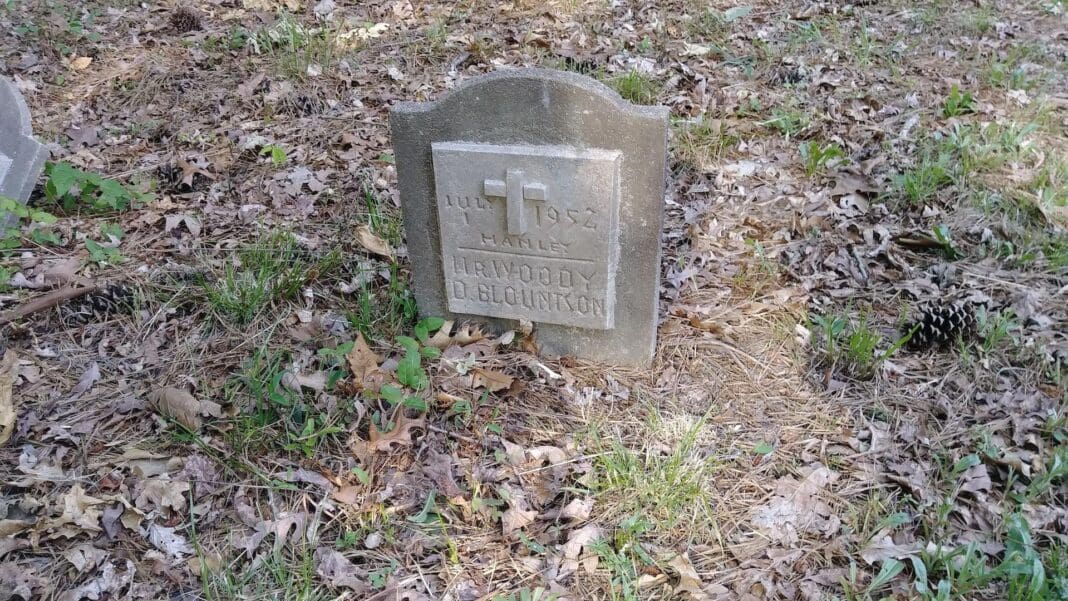The Atlanta Journal-Constitution recently published a story about a Black cemetery in Buckhead, a prosperous Atlanta community.
The cemetery broke ground almost two centuries ago, in 1826, as the graveyard of Piney Grove Baptist Church. The church has been gone for decades; the cemetery now sits on the property of a townhouse development. It is overgrown, with most of its 300-plus graves unmarked.
The article describes how some of the buried’s descendants and family members are trying to get the property owner to clean up and take care of the cemetery.
Audrey Collins is one of those descendants. Her grandmother, Lenora Powell Thomas, is buried there, and a photograph of her grandmother’s headstone accompanied the article.
The headstone is not one of those polished markers that you are probably used to seeing. It is small, perhaps 18 inches tall. It has a rough, poured concrete base with a plaster inset, which includes the name of the funeral home, the name of Collins’ grandmother and the date of her death. Her name reads, “Mrs. Lenora Thomas.”
Those first three letters – Mrs. – might be the most important on the headstone.
The courtesy titles Mr., Mrs. and Miss rarely appear on headstones; usually it is just the first and last name.
But here, they serve an important function, reminding viewers of how Black Americans came up with creative ways to retain their dignity and weather the dehumanizing effects of racism.
In September 1951, the Savannah Tribune, a Black newspaper, complained about a couple of items that had recently appeared in the white press.
One was a report of a white woman who was convicted of “operating and maintaining a lewd house.” The newspapers put “Mrs.” before her name. The second item was an announcement of the principals in the city’s “colored schools.” The names of the female principals were given without the courtesy titles of “Miss” or “Mrs.” The difference was literally Black and white.
When you hear about life in the Jim Crow South, you might think of segregated schools, city buses and lunch counters.
But subtler slights were part of everyday life. White Southerners refused to refer to African Americans with the courtesy titles Mr., Mrs. or Miss, depriving them of their dignity. In the late 1970s, Benjamin Mayes, president of Atlanta’s Morehouse College, recounted how “‘Mr.’ and ‘Mrs.’ and ‘Miss’ were signs of social equality. They didn’t call you that.”
This denial of Black dignity was pervasive. A 1935 study of 28 Southern white newspapers found none that used courtesy titles for Black Americans. In a 1964 article, the Atlanta Daily World noted that in the telephone book “Miss” or “Mrs.” appeared before the names of white women; for Black women, it was just “Susie Smith” or “Jenny Davis.”
Only in the 1960s did this begin to change. Mary Hamilton, a civil rights activist, was arrested at a demonstration in Gadsden, Alabama, in 1963. In the courtroom, the prosecutor asked her a question, addressing her as “Mary.”
“I won’t respond,” Hamilton said, “until you call me Miss Hamilton” – which is how he had been addressing white women on the stand. The judge ordered her to answer the question, and, when she refused, he sentenced her to a few days in jail for contempt of court.
Her appeal reached the Supreme Court, which ruled that judges and lawyers do have to use “Miss” and other honorifics for Black witnesses, just as they do for white people.
In the 1940s, Black funeral directors in Atlanta came up with a way to combat this dehumanization: grave markers that anointed their dead with the courtesy titles that white society had denied them.
There are hundreds of headstones like Mrs. Thomas’ in older Black cemeteries in the Atlanta area. Most of those markers were made by Eldren Bailey, an artist who worked in concrete and plaster. They are beautiful in their simplicity. And they all clearly say “Mr.,” “Mrs.” or “Miss.”
These grave markers were sold as part of a funeral package, so they each bear the name of one of a dozen or so African American funeral homes in Atlanta: Hanley, Cox Brothers, Ivey Brothers, Haugabrooks, Sellers, Murdaugh and others.
One historian noted that “black funeral directors not only regularly participated in the fight for racial equality but also made significant contributions to the cause.” That was certainly true of Geneva Haugabrooks, who established the Haugabrooks Funeral Home in 1929. She was active in the Atlanta Negro Voters League, and she supported the Negro Motorist Green Book. In 1953, the Atlanta chapter of the NAACP honored her for “the valuable work she has done locally and nationally.”
I do not know who came up with the idea of using honorifics in these markers. Perhaps it was Mrs. Haugabrooks, whose funeral home appears on some of the oldest.
In any case, I believe they are worth preserving and remembering, as they restored, in death, a sense of dignity to people who had been denied it in life.
This article is republished from The Conversation, an independent nonprofit news site dedicated to sharing ideas from academic experts. The Conversation is trustworthy news from experts, from an independent nonprofit. Try our free newsletters.
Read more: 6 books that explain the history and meaning of Juneteenth During the holidays, giving gifts to the dead can help you cope with grief
David B. Parker does not work for, consult, own shares in or receive funding from any company or organization that would benefit from this article, and has disclosed no relevant affiliations beyond their academic appointment.








